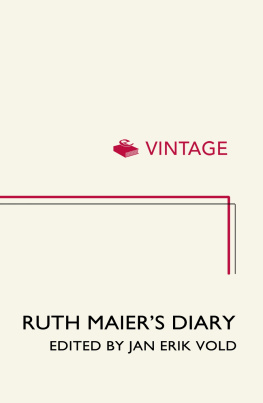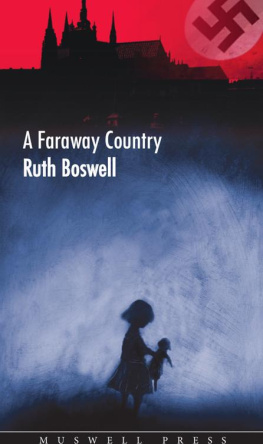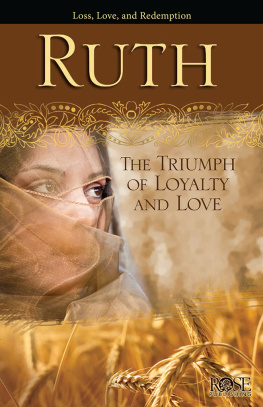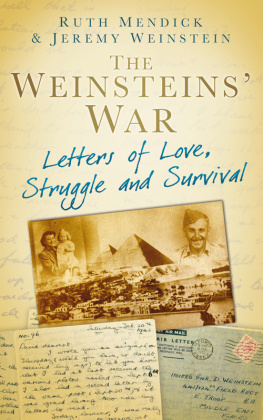CONTENTS
About the Author
Ruth Maier was born into a middle-class Jewish family in interwar Vienna. She emigrated to Norway and was deported to Auschwitz in November 1942, where she was killed on arrival, aged only twenty-two. Ruths diary is a testament to the remarkable writer she could have become.
The diary came to light after the books editor, Jan Erik Vold, found sections of the manuscript amongst the papers of Ruths friend, the eminent Norwegian poet, Gunvor Hofmo, following her death in 1995.
About the Book
Published only recently for the first time in Norway, Ruth Maiers Diary is one of the most moving testimonies to emerge from the Nazi era.
Ruth Maier was born into a middle-class Jewish family in interwar Vienna. Following the Anschluss of Austria in March 1938, her world collapsed. In early 1939, her sister having left for England, Ruth was allowed to go to Norway and lived with a family in Lillestrm, near Oslo. Although she loved many things about her new country and its people, Ruth became increasing isolated until she met a soulmate, Gunvor Hofmo, who was to become a celebrated poet. When Norway became a Nazi conquest in April 1940, Ruths efforts to join the rest of her family in Britain became ever more urgent.
Ruth Maier kept a diary from 1934 until she was deported to Auschwitz in 1942 at the age of twenty-two. Although she was only in her teens, she shows a sophisticated understanding of the political forces shaping Europe. Ruth is lyrical, witty and incisive and explores universal themes of isolation, identity, love, friendship, desire and justice. Most of all, she seeks what it means to be a human being.
Ruth Maiers Diary
A Jewish Girls Life in Nazi Europe
Ruth Maier
Translated from the German by
Jamie Bulloch

www.vintagebooks.co.uk
TRANSLATORS NOTE
The literary qualities of Ruth Maiers diaries and letters have been widely acknowledged. In a lucid, yet often highly lyrical style, Ruth displays a skilful talent for narrative and drama, and rounds these off with a sharp wit. Given her unquestionable flair for writing, it is easy to forget that we are reading spontaneous material in its first and only draft, never intended for publication. When translating the diaries this raises the issue of how much revision and editing is justifiable. Can we possibly improve the text, or does such an approach detract from the authenticity and immediacy of the work?
As would be expected, we have removed orthographical and grammatical errors, while the punctuation has been cleaned up for reasons of clarity. Stylistic polishing is a more contentious issue, and applied indiscriminately can ruin the colour of the original text. In this instance, the approach has been to reproduce Ruths voice as faithfully as possible, while eliminating or modifying the occasional idiosyncrasy that could jar with an English-language audience. I have endeavoured to adopt a style that might not have been totally alien to a girl growing up in 1930s Britain with a similar social background to Ruth. At the very least I hope I have managed to avoid howling linguistic anachronisms.
In his introduction, Jan Erik Vold explains the editorial procedure undertaken for the Norwegian edition of the book, which involved being very selective with the first volume of Ruths diary while reproducing the later ones in full. We have implemented a few more cuts of our own; these do not affect the diary entries or letters, only the poems dotted throughout the text. A larger proportion of the poetic material written towards the end of Ruths life has been kept in, as this reflects the balance of her diary output at the time: fewer descriptions of day-to-day life, and more short prose pieces.
Finally I should like to express my warmest gratitude to Ruth Maiers sister, Mrs Judith Suschitzky, who has taken the trouble to look carefully through the English proofs. This is the first time she has seen a lot of the material reproduced here, and her contribution to the finished book has been invaluable. Many thanks are also due to Jan Erik Vold. Both he and Mrs Suschitzky have helped clear up issues we could never have worked out for ourselves, highlighted errors and offered suggestions which have improved the quality of the text.
Jamie Bulloch
November 2008
FOREWORD
One of us
Ruth Maier was a refugee from Austria. She arrived in Norway before the war and stayed for four years before being arrested as part of a large round-up of Jews in late autumn 1942. Together with hundreds of other Jews she was put on board the ship Donau and deported. Ruth was born on 10 November 1920 in Vienna and died on 1 December 1942 in Auschwitz.
Ruth kept a diary throughout her life. The earliest surviving entries were written when she was twelve. The final volume was completed two days after her twenty-second birthday. Eight books of diaries and fifty letters survive from the period 1933 to 1942: the daily, weekly and monthly observations of an enquiring and educated young woman with artistic talents in many fields. Her friend Gunvor Hofmo, the Norwegian poet, kept these diaries for more than fifty years.
Around 1,100 diary pages and 300 pages of letters have been found, and these have been turned into a 400-page book.
At the end of January 1939, Ruth arrived in Norway from the German Reich as an eighteen-year-old schoolgirl, settling in the small town of Lillestrm, close to Oslo. In 1940 she took her school-leaving exams and then met a group of Norwegian friends while working in the womens labour service. One of these was Gunvor Hofmo, with whom she travelled across Norway for two years, taking odd jobs in various places. In September 1942 she moved into a young womens boarding house in Oslo, where she attended courses at the arts and crafts college, and earned money painting souvenirs.
Ruth left behind diaries, letters, literary texts, as well as many watercolours and drawings. She also left good memories among those who survived her, a handful of whom are still with us today. From the very start Ruth had a profound influence on Gunvor Hofmos poetry (even if her name is not actually mentioned):
On a rainy night like this
you feel her close presence,
a Jewish friend they killed,
she whose body they burned,
among thousands of others.
Of Ruth Maiers last journey we know this: 188 women, 42 children and 116 men unfit for work aboard the Donau were taken to the gas chambers immediately upon their arrival in Auschwitz. The bodies were burned in the open air. No death certificate exists for any of these 346 individuals.
Ruth Maiers name appears in two places in Oslo: on the memorial for Jewish war victims in the eastern cemetery, and on a plaque commemorating students from the arts and crafts college who were killed during the war. In Dbling cemetery in Vienna her name is engraved on the tombstone of her mother and father.

Here are some details about her family background. Ruth grew up in a secure and comfortable middle-class home in Vienna, which she shared with her father, mother and younger sister, Judith. The family belonged to the well-established community of secularised Jews in the Austrian capital. Ludwig Maier was a senior official in the Austrian postal service, and Secretary General of the Postal, Telegraph and Telephone International (the PTTI). He held a doctorate in philosophy and spoke nine languages. Ruth had a close bond with her father. The relationship with her mother, Irma, was more ambivalent. When Ruth was thirteen her father died of the severe bacterial infection erysipelas. Ludwigs brother, Robert, a bank manager in Brno, Czechoslovakia, now became the familys guardian. Irmas brother, Oskar, a dedicated communist in Moscow, was another uncle with a strong character.
Next page













